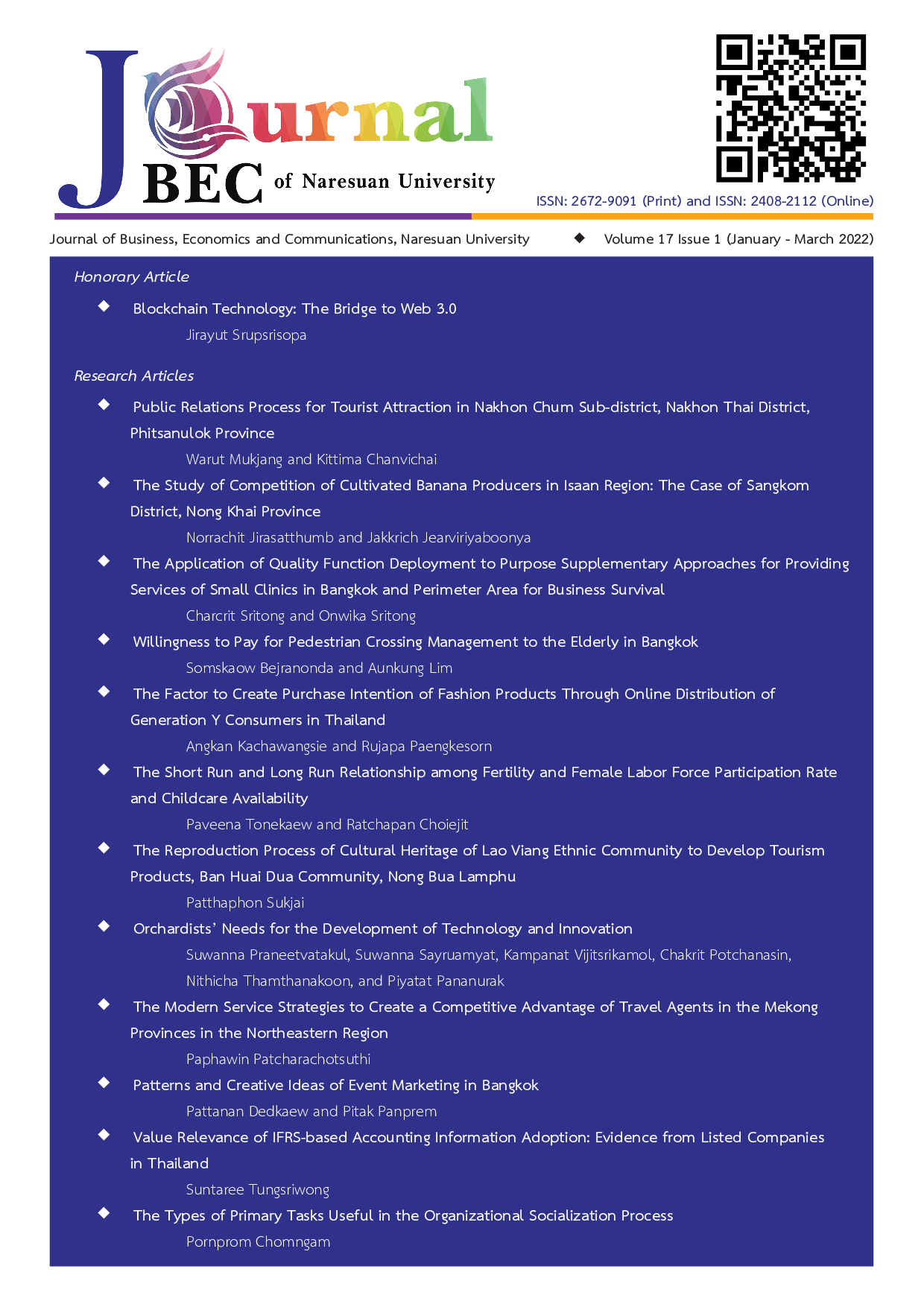The Short Run and Long Run Relationship among Fertility and Female Labor Force Participation Rate and Childcare Availability
Main Article Content
Abstract
The objective of this study was the short run and long run relationships among fertility and female labor force participation rate and childcare availability. The results showed that there were the short and long run relationships among fertility and female labor force participation rate and childcare availability which measured in terms of number of children to nursery ratio; however, there was no long run relationship between fertility and female labor force participation rate. Moreover, there were short run relationships between childcare availability and fertility in all aged groups of females except female aged 25-34. There were also short run relationship from the female aged 35-49 labor force participation rate to their fertility and the childcare availability. Thus, childcare availability access and development, in terms of accessibility and quality would increase fertility rate.
Article Details

This work is licensed under a Creative Commons Attribution-NonCommercial-NoDerivatives 4.0 International License.
References
Asteriou, D. and Hall, S. G. (2007). Applied econometrics: A modern approach using EViews and Microfit. New York: Palgrave Macmillan.
Baizan, P. (2009). Regional child care availability and fertility decisions in Spain. Demogr. Res, 21, 803–841.
Becker, G. (1985). Human capital, effort, and the sexual division of labor. Journal of labor economics, 33-58.
Becker, G. (1960). An economic analysis of fertility. In: Demographic and Economic Change in Developed Countries. Bangkok: National Bureau of Economic Research, Princeton.
Buhari, D. and Mürsel, A. (2017). Female Labor Force Participation Rate and Economic Growth in the Framework of Kuznets Curve: Evidence from Turkey. Review of Economic & Business Studies, 10 (1), 33-54.
Castles, F. G. (2003). The world turned upside down: below replacement fertility, changing preferences and family-friendly public policy in 21 OECD countries. Journal of European social policy, 13(3), 209-227.
De Tray N. and Dennis. (1973). Child Quality and the Demand for Children. Journal of Political Economy, 81(2), 70-95.
Dickey, D. A. and W. A. Fuller. (1979). Distribution of the estimators for autoregressive time series with a Unit Root. Journal of the American Statistical Association, 74, 427-431.
Floge, L. (1989). Changing household structure, child-care availability, and employment among mothers of preschool children. J. Marriage Family, 51(1), 51–63.
Grace H.Y. Lee and Sing Ping Lee. (2014). Childcare availability, fertility and female labor force participation in Japan. J. Japanese Int. Economies, 32, 71–85.
Gujarati, D. N. and Porter, D. C. (2009). Basic econometrics. 5th Edition, New York: McGraw Hill Inc.
Heckman, J. (1978). A Partial Survey of Recent Research on the Labor Supply of Women. American Economic Review, 68, 200-207.
Herbst, C.M. and Barnow, B.S. (2008). Close to home: a simultaneous equations model of the relationship between child care accessibility and female labor force participation. J. Fam. Econ. 29 (1), 128–151.
Hotz, V.J., Klerman, J.A. and Willis, R.J. (1997). The economics of fertility in developed countries. In: Rosenzweig, M.R., Stark, O. (Eds.), Handbook of Population and Family Economics, Amsterdam: Elsevier.
Ikeda, S. (2010). Company size and childcare leave: the problems of support for women’s job continuity. Jpn. Labor Rev. 7(1), 119–139.
Johansen, S. (1988). Statistical Analysis of Cointegration Vectors. Journal of Economic Dynamics and Control, 12 (2–3), 231–254.
Kaewbuadee, N. and Pothisiri, W. (2019). Delaying age at first birth of ever-married women in Thailand: situation, trend, and determinants. Srinakharinwirot Research and Development. Journal of Humanities and Social Sciences. 11(22). 57-74.
Kanjanachitra, M. and Liengromruen, N. (2014). Birth and security in population and society: Policy when the era of the gold chain resonates. (1st ed.) Nakorn Pathom: Institute for Population and Social Research. Mahidol University.
Kreyenfeld, M. (2010). Uncertainties in female employment careers and the postponement of parenthood in Germany. European Sociological Review, 26(3), 351-366.
Liefbroer, A. C. and Corijn, M. (1999). Who, what, where, and when? Specifying the impact of educational attainment and labour force participation on family formation. European Journal of Population/Revue Européenne de Démographie, 15(1), 45-75.
Nakamura, J. and Ueda, A. (1999). On the determinants of career interruption by childbirth among married women in Japan. J. Jpn. Int. Econ. 13, 73–89.
National Statistical Office. (2017). Important conclusions working for women in Thailand 2016. Bureau of Economic and Social Statistics. National Statistical Office.
Ozcan, B., Mayer, K. U. and Luedicke, J. (2010). The impact of unemployment on the transition to parenthood. Demographic Research, 23(29), 807-846
Presser, H. B. and Baldwin, W. (1980). Child care as a constraint on employment: prevalence, correlates, and bearing on the work and fertility nexus. Am. J. Sociol. 85(5), 1202–1213.
Rica, S. and Ferrero, M.D. (2003). The effect of fertility on labor force participation: the Spanish evidence. SpanEconRev, 5 (2), 153–172.
Richter, K., Podhisita, C., Chamratrithirong, A. and Soonthorndhada, K. (1994). The impact of child care on fertility in urban Thailand. Demography, 31, 651–662.
Rindfuss, R.R., Guilkey, D.K., Morgan, S.P. and Kravdal, Q. (2010). Child-care availability and fertility in Norway. Popul. Develop. Rev. 36(4), 725–748.
Samutchak, P. (2015). Low birth and decline in Thai productivity. Productivity world, 20 (114), 54-58.
Santarelli, E. (2011). Economic resources and the first child in Italy: A focus on income and job stability. Demographic Research, 25, 311.
Smith-Lovin, L. and Tickamyer, A. (1978). Nonrecursive models of labor force participation, fertility behavior, and sex role attitudes. Am. Sociol. Rev. 43, 541–557.
Stolzenberg, R.M. and Waite, L.J. (1984). Local labor markets, children and labor force participation of wives. Demography, 21(2), 157-170.
Willis, R. J. (1987). What have we learned from the economics of the family? Am. Econ. Rev, 77 (2), 68–81.
Winkler-Dworak, M. and Toulemon, L. (2007). Gender differences in the transition to adulthood in France: is there convergence over the recent period?. European Journal of Population/ Revue européenne de Démographie, 23(3-4), 273-314.


